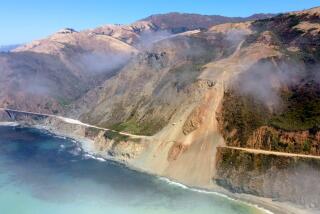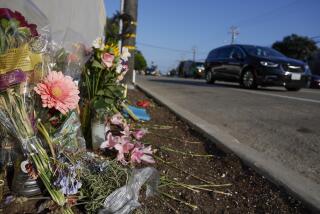Scary Idea: Driving Hawaii’s Forbidden Highway : HAWAII: the Forbidden Highway
- Share via
I used to think this was a free country. That’s why I got a jolt when I found out that I was forbidden to use certain Hawaiian state highways.
The official word they used was “prohibited,” in a red-stamped warning across my Big Island car-rental contract: “Driving the Saddle Road in a rental car is prohibited and is entirely at the driver’s risk and expense.”
I asked the woman behind the desk why, and she said it was “because the Saddle Road isn’t a state highway. Or something like that.”
When I said the Saddle Road was Hawaii State Highway 200, she said the reason was that the car-rental insurance doesn’t cover the Saddle Road.
But later I found out what may be a better reason--the Saddle Road is haunted.
A hotel desk clerk first volunteered the information, later confirmed by residents all over the Big Island.
A Scary Place
“It’s a ghosty, scary place up there. Strange things happen. Some friends told me they’ve seen night walkers along certain paths up there, wearing old-time clothes . . . and I mean really old-time, like feather capes and helmets and things . . . carrying torches.
“And you know, people see Madame Pele (the ancient Hawaiian volcano goddess) all the time up there. She can change herself in a second. You might see her as a woman walking along the road one minute, then poof, all you see is a dog or a rabbit.”
The security guard spoke up next. “That’s right. Funny things really do happen up there. Once me and my brother looked up at the sun and began to see things. I asked him, ‘Do you see what I see?’ ‘Yeah. Two planets next to the sun.’ We got out of there real quick.
“Then another time my car started slowing down and I couldn’t do anything about it. I knew Pele must’ve been around there somewhere. And I’m not even superstitious.”
The next day I decided to see for myself. I drove the Saddle Road both ways and found some good reasons why few tourists take the risk. Besides saving a good hour in cross-island driving time I found that it was an easy way to see the starkly beautiful, seldom-visited lava fields that blanket most of the Big Island’s interior.
The middle 20 miles around the saddle-summit is a moonscape of cinder cones and frozen black lava rivers from the Mauna Kea and Mauna Loa volcanoes, which jointly form the saddle that gives the road its name.
World’s Biggest Mountain
Besides, I got a kick out of seeing the world’s biggest mountains close up. Measured from the ocean floor, Mauna Kea--13,796 feet above water--tops 32,000 feet, making it the world’s tallest peak.
Mauna Loa, on the other hand, is bigger than many entire mountain ranges. Geologists agree that it is the world’s most massive single mountain; it amounts to as much rock as California’s entire Sierra Nevada.
From the saddle-summit in mid-island, both peaks loom dark and awesome--Mauna Kea pockmarked with a dozen brown craterlets and, on the opposite side, Mauna Loa sprawling across the horizon like some gigantic slumbering black dinosaur.
Adventurous travelers can follow the branch roads from near the saddle-summit up the slopes of both mountains. They drive up through the eerie jumble of lava tubes, cinder cones and brightly painted miniature volcanoes that decorate each mountain’s slope.
The Mauna Kea road ends a few hours’ walk from the summit, while the Mauna Loa branch takes a four-wheel-drive vehicle to within a day’s hike of the summit shelter (good weather only), where backpackers may camp on a first-come, first-served basis.
It’s always winter atop 13,680-foot Mauna Loa, so prepare accordingly; first register at the National Park Visitor Center near Kilauea Crater and heed their handy information sheet.
Narrow, Winding, Bumpy
There are some equally persuasive reasons for not traveling the Saddle Road. It’s a very narrow, often winding, bumpy, potholed, sometimes slippery asphalt road with no services for 50 miles. It’s not the Hawaii everyone knows; it climbs over the chilly, 7,000-foot lava desert that the Army sometimes uses for an armored warfare training ground. Consequently, the countryside is full of unexploded shells.
Besides all that, I found it to be super-tricky because of the straight portions, where more than once I got fooled into stepping on the gas, only to suddenly hit an unmarked curve. Had it been slippery--well, I don’t like to think about it.
So if you want a safe and sane cross-island route, do as most residents do and follow the north shore Highway 19, or Highway 11 around the island’s southern tip.
Hire a Driver
But if you decide that the sights are worth the risks, hire a driver or try getting all-inclusive rental-car insurance before you leave home.
The Valley Isle of Maui has its share of forbidden roads; the rental contract stipulates, “Driving on unpaved roads, including unpaved portions of highways, is prohibited and at renter’s risk and expense.”
Again I asked questions at the airport rental counter.
“Does this ‘prohibited’ mean illegal according to law?”
“No, not actually. Our car-rental insurance doesn’t cover driving on unpaved roads, so we have to spell it out on the contract.”
The roughest road I found on Maui was Highway 31, which curves, unpaved, around the island’s southern tip. This track is the continuation of the relatively safe Hana Highway 360, the magnificent coast road that twists two hours south from central Maui to the village, aptly labeled “Heavenly Hana.”
Tropical Greenery
The point of driving the Hana Highway is what you find along the way. Tropical greenery seems to surround you each time you steer your way through one of its tiny waterfall valleys such as Haipaena and Waikaui, names as delicious as their splash-music a few steps from the roadside.
Along the way the pavement narrows at no fewer than 54 little bridges, each with a name such as Precious Love, Burning Star or Second Ruffled Waters.
About halfway to Hana, watch on the left for the small roadside sign that leads you downhill to the little Keanae Peninsula. There you see the breakers rise from the turquoise bay and flood the deeply scalloped, dusty-rose tide pools with their rolling, roaring carpet of foam. Look up and see the palm clusters sway seaward as their feathers bow and brush the coral sand.
Nearby at the peninsula tip, stop by the ancient stone Keanae Congregational Church and linger beneath the exquisite old palm grove that surrounds it.
A visit to Hana wouldn’t be complete without a stop at Hasegawa’s general store a mile past the police station, just after the Chevron station. You’ll find shelves crammed with every imaginable item, from Barbie dolls and two-pound fishhooks to Playgirl magazines and frozen tripe, including the kitchen sink.
Seven miles past Hasegawa’s, the road, now Highway 31, plunges into the jungle of little Wailua Valley, where the creek plummets 100 feet and splashes into an inky, circular pool a stone’s throw from roadside.
More Than Seven Pools
The pavement ends a few miles farther, just after Oheo Creek that meanders over cliffs and rocks, dallying in a host of black hollows in its solid lava stream bed.
This spot came to be called Seven Sacred Pools, although the desk staff at Hawaii Volcanoes National Park swears there are many more than seven pools and they never were sacred. Now they are a unit of Haleakela National Park, and a beautiful place where you can spend an afternoon splashing under the waterfalls.
Shortly past the parking lot the road slips by tiny Palapala Hoomau Church, the grave site of aviator Charles Lindbergh.
The road, now very rough, continues 26 miles until its intersection with Highway 37 a difficult two hours later. The track is narrow, rocky and spectacular where it threads the shoreline base of Haleakela Volcano, whose awesome bulk is lost somewhere above the clouds, and where the breakers foam below the cliff just outside the car window.
For the ordinary driver, however, there is the constant danger of getting stuck, losing traction or cracking an axle or the oil pan.
After a steep, rocky uphill stretch the road improves but bumps along through Maui’s wildest, loneliest coastal stretch, empty except for a few scattered ranches, two abandoned ancient white stone churches and the tiny settlement of Kaupo that huddles around its rickety, often closed store.
So you see, Highway 31 is a risky proposition for the average driver; but if you’re determined to explore this wild, empty corner of Hawaii, rent a high-clearance, insured vehicle and try it in good weather. If it’s raining, forget it.
Along the island’s north shore, Hawaii 340, Maui’s other forbidden highway, rounds the rocky, wind-swept coast past the hamlet of Kahakuloa.
Road Narrows
Traveling north from Kahului and Wailuku the road narrows after Waihee, then winds high above the surf and threads along the cliffs, ducking into little canyons, climbing out over their shoulders, while switching between gravel and asphalt surface for several miles.
Soon the towering sugar-loaf of Kahakuloa Head marks your approach to Kahakuloa village and bay. Pull off at the wide spot at the top of the cliff above the village and gaze down over the bay’s palm-fringed, foamy-turquoise crescent and watch the breakers roll and smash against the beach 500 feet below.
Look down and see the green taro fields and the rustic houses of fisherfolk that dot the quiet valley that separates Kahakuloa’s tiny Catholic and Congregational churches.
Half-a-mile downhill at the Kahakuloa stream bridge the road worsens to a steep, rocky stretch, safely passable by high-clearance vehicles only. Three miles later the road widens, the pavement resumes, then winds a dozen more miles through little tropical valleys, past their rocky beaches and up over their breezy headlands until it meets the high-speed Highway 30 at Honokahau Store.
Next time I’m going to drive a rental Jeep up the Saddle Road to Mauna Loa so I can return a bagful of glassy lava rocks that I borrowed from atop the mountain years ago. Madame Pele let me take them only because I vowed to return someday; and, as any islander will warn you, Pele is not to be trifled with. So I dare not keep her waiting. And I’m not the least bit superstitious.
Even on Ohau, car rentals need not be expensive if you rely on local companies, many of which offer good service at reasonable rates. Dozens are listed in the Oahu Yellow Pages at your city library.
More to Read
Sign up for The Wild
We’ll help you find the best places to hike, bike and run, as well as the perfect silent spots for meditation and yoga.
You may occasionally receive promotional content from the Los Angeles Times.






